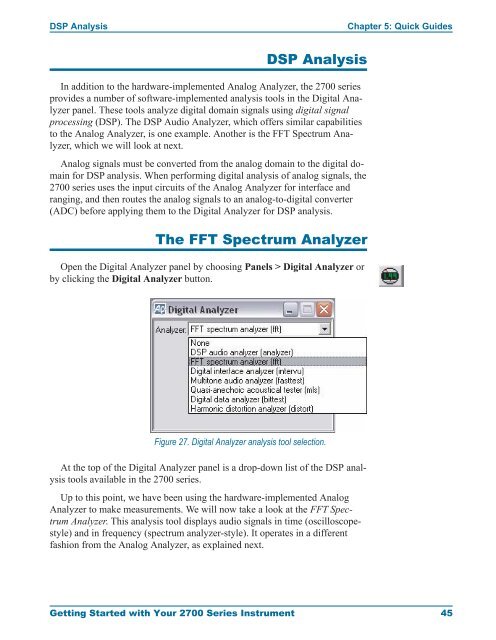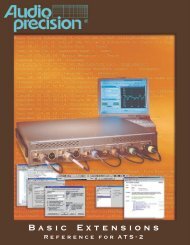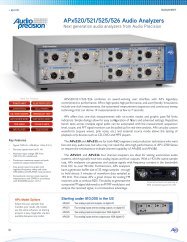Getting Started with Your 2700 Series Instrument
Getting Started with Your 2700 Series Instrument
Getting Started with Your 2700 Series Instrument
You also want an ePaper? Increase the reach of your titles
YUMPU automatically turns print PDFs into web optimized ePapers that Google loves.
DSP Analysis Chapter 5: Quick Guides<br />
DSP Analysis<br />
In addition to the hardware-implemented Analog Analyzer, the <strong>2700</strong> series<br />
provides a number of software-implemented analysis tools in the Digital Analyzer<br />
panel. These tools analyze digital domain signals using digital signal<br />
processing (DSP). The DSP Audio Analyzer, which offers similar capabilities<br />
to the Analog Analyzer, is one example. Another is the FFT Spectrum Analyzer,<br />
which we will look at next.<br />
Analog signals must be converted from the analog domain to the digital domain<br />
for DSP analysis. When performing digital analysis of analog signals, the<br />
<strong>2700</strong> series uses the input circuits of the Analog Analyzer for interface and<br />
ranging, and then routes the analog signals to an analog-to-digital converter<br />
(ADC) before applying them to the Digital Analyzer for DSP analysis.<br />
The FFT Spectrum Analyzer<br />
Open the Digital Analyzer panel by choosing Panels > Digital Analyzer or<br />
by clicking the Digital Analyzer button.<br />
Figure 27. Digital Analyzer analysis tool selection.<br />
At the top of the Digital Analyzer panel is a drop-down list of the DSP analysis<br />
tools available in the <strong>2700</strong> series.<br />
Up to this point, we have been using the hardware-implemented Analog<br />
Analyzer to make measurements. We will now take a look at the FFT Spectrum<br />
Analyzer. This analysis tool displays audio signals in time (oscilloscopestyle)<br />
and in frequency (spectrum analyzer-style). It operates in a different<br />
fashion from the Analog Analyzer, as explained next.<br />
<strong>Getting</strong> <strong>Started</strong> <strong>with</strong> <strong>Your</strong> <strong>2700</strong> <strong>Series</strong> <strong>Instrument</strong> 45




